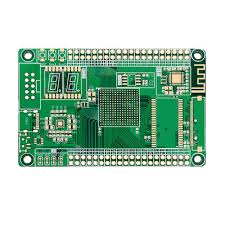Introduction

In the era of hyper-connectivity, the evolution of 5G technology has brought about an unprecedented leap in wireless communication. From smartphones and IoT devices to autonomous vehicles and industrial automation, 5G enables ultra-fast data transfer, ultra-low latency, and seamless device interconnection.
At the heart of this revolution lies the 5G Module PCB — the foundational platform that supports every high-speed signal, RF pathway, and intelligent operation within a 5G system. As a trusted high-frequency PCB manufacturer, KKPCB provides precision-engineered PCB solutions for 5G modules, ensuring uncompromised performance, signal integrity, and power efficiency across complex multi-band networks.
What Is a 5G Module PCB?
A 5G Module PCB is a high-frequency printed circuit board designed to host 5G communication modules, antennas, and RF front-end components. It functions as the core interconnection platform between digital processors, power systems, and RF transmission units, managing signal routing, impedance control, and heat dissipation in high-density communication systems.
Compared with traditional LTE or 4G boards, 5G module PCBs must meet stricter requirements for dielectric stability, low loss tangent, and multilayer precision to handle frequencies up to 40 GHz and beyond.
Key Features of 5G Module PCBs
-
High-frequency support: Designed for Sub-6 GHz and mmWave (24–100 GHz) transmission.
-
Low signal loss: Use of advanced materials like Rogers, Taconic, or Panasonic Megtron series.
-
Multi-layer structure: Typically 8–16 layers for complex RF and digital routing.
-
Thermal management: Integration of heat-dissipating copper planes and metal-backed substrates.
- Miniaturized design: Compact layout for 5G module embedding in small devices such as smartphones, IoT gateways, and industrial routers.

Core Components of 5G Module PCBs
1. 5G Baseband Processor
The baseband chip acts as the brain of the 5G module, processing massive MIMO data streams, managing multiple frequency bands, and executing real-time modulation and demodulation.
2. RF Front-End Module (RFFE)
This includes power amplifiers (PA), low-noise amplifiers (LNA), filters, and duplexers, ensuring signal amplification and clean transmission across Sub-6 GHz and mmWave frequencies.
3. Antenna Array Integration
Modern 5G module PCBs integrate multi-antenna arrays directly on the board, using AiP (Antenna-in-Package) or AiM (Antenna-in-Module) technologies to enhance beamforming and signal precision.
4. Power Management Circuit
To maintain stability under high-speed operation, 5G PCBs use advanced PMICs (Power Management ICs) for dynamic voltage regulation and energy optimization.
5. High-Speed Interconnects
The PCB incorporates controlled impedance traces and grounded coplanar waveguides (GCPW) to ensure minimal insertion loss and excellent signal integrity.
Design Challenges in 5G Module PCBs
Signal Integrity at High FrequenciesAt frequencies beyond 30 GHz, even slight impedance mismatches can cause severe reflection and phase distortion. KKPCB ensures precise impedance control (±5%) and uses low-loss materials to maintain clarity in high-speed RF transmission.
- Thermal Management
- 5G components generate substantial heat. KKPCB utilizes metal-backed laminates, thermal vias, and heat-spreading copper planes to manage temperature rise and enhance reliability.
- Miniaturization & Integration
- As 5G modules shrink, PCBs must accommodate tighter routing, smaller components, and multi-layer stacking without sacrificing electrical performance.
- Material Compatibility
- KKPCB selects Rogers RO4350B, RO4003C, or Megtron 6 substrates, which provide stability under high-frequency operation and minimal dielectric loss (Df < 0.003).
Applications of 5G Module PCBs
Smartphones & Wearables
5G module PCBs enable ultra-fast data transfer and high-efficiency power distribution in modern devices.
Automotive Radar & V2X Communication
Used in 77 GHz radar systems and vehicle-to-everything (V2X) modules for autonomous driving.
Industrial IoT (IIoT)
Supports high-reliability 5G modules in smart factories for real-time monitoring and robotic communication.
Telecom Infrastructure
Applied in 5G base stations, small cells, and edge computing nodes, where signal stability and heat resistance are critical.
KKPCB’s Advantage in 5G Module PCB Manufacturing
High-Frequency Expertise
Over 15 years of experience in RF and microwave PCB production, supporting frequencies up to 110 GHz.

Material Precision
Partnership with Rogers, Panasonic, and Isola ensures consistent dielectric performance and reliability.
Advanced Fabrication
Supports HDI, hybrid multilayer stack-ups, and mixed-material lamination for high-density 5G module boards.
Comprehensive Testing
Each PCB undergoes impedance, S-parameter, and thermal stress testing to ensure top-tier reliability and repeatability.
Conclusion
As 5G reshapes industries and daily life, the 5G module PCB stands at the intersection of speed, intelligence, and reliability.
From millimeter-wave communication to smart manufacturing, these boards are the unseen backbone of next-generation connectivity.
At KKPCB, we are committed to delivering high-frequency, low-loss PCB solutions that empower the global shift toward intelligent, connected systems — one module at a time.

